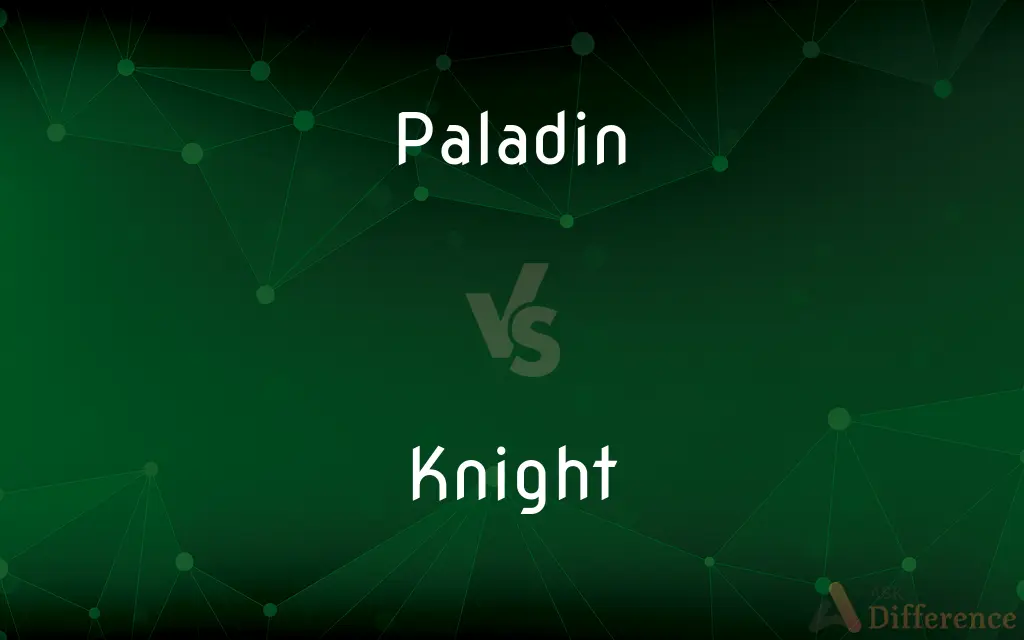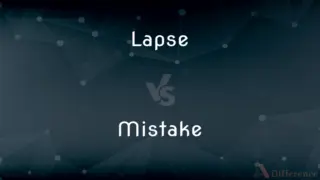Paladin vs. Knight — What's the Difference?
By Urooj Arif & Maham Liaqat — Updated on March 20, 2024
Paladins are often depicted as holy knights with a focus on righteousness and divine powers, while knights are medieval warriors known for their martial prowess and code of chivalry.

Difference Between Paladin and Knight
Table of Contents
ADVERTISEMENT
Key Differences
Paladins, in historical and fantasy contexts, are portrayed as warriors imbued with divine powers or blessings, making them champions of causes greater than mere feudal loyalty or battlefield valor. They are often associated with virtues like justice, mercy, and piety, serving as holy warriors in the service of a higher power or cause. Knights, on the other hand, are typically seen as heavily armored warriors of the medieval period, sworn to serve a liege lord or king, with their roles primarily centered around martial prowess, loyalty, and adherence to the chivalric code, which includes honor, bravery, and courtesy.
The concept of a paladin is deeply rooted in Charlemagne's legends, where they were depicted as the foremost warriors of the king's court, embodying both martial and moral excellence. This is in contrast to the broader category of knights, who could range from noble heroes to simple soldiers of fortune, with their status often derived from feudal obligations or earned through valor in combat. While all paladins could be considered knights in the sense of being elite warriors, not all knights would meet the stringent moral and spiritual standards associated with paladins.
In terms of equipment and fighting style, both paladins and knights are often depicted wearing armor and wielding swords, but paladins are also frequently attributed with magical or divine abilities, such as healing powers or the ability to smite evil. Knights, while sometimes depicted as having legendary weapons or armor, do not typically have inherent magical abilities, focusing instead on their combat skills, strategy, and leadership on the battlefield.
Paladins occupy a special place in literature and gaming, symbolizing the ideal of the warrior who fights not just for earthly kings or personal glory but for a higher moral or spiritual purpose. Knights, while also celebrated in tales of heroism and adventure, are more grounded in the historical realities of the medieval world, with their stories often reflecting the complexities of feudal loyalty, honor, and the harsh realities of medieval warfare.
While paladins are characterized by their divine sanction and commitment to a higher moral code, knights are defined by their feudal duties, martial skill, and adherence to the chivalric code. This distinction highlights the spiritual and moral dimensions that set paladins apart from their knightly counterparts, underscoring the former's role as not just warriors, but as paragons of virtue in a troubled world.
ADVERTISEMENT
Comparison Chart
Origins
Rooted in the legends of Charlemagne's court
Medieval European warriors
Role
Divine warriors, champions of justice and faith
Feudal warriors, serving lords and kings
Abilities
Martial prowess combined with divine or magical powers
Primarily martial prowess and combat strategy
Ethical Code
Upholds a divine or holy cause, focused on righteousness
Follows the chivalric code, emphasizing honor and bravery
Cultural Symbolism
Represents the ideal of moral and spiritual warriorship
Embodies the ideals of chivalry, loyalty, and martial excellence
Equipment
Armor, weapons, and often depicted with symbols of faith
Armor and weapons, sometimes with legendary items
Fictional Portrayal
Often featured in fantasy settings as heroes with magical abilities
Depicted in historical and fantasy contexts, focusing on their adventures and battles
Motivation
Serving a higher power or cause, beyond mere feudal allegiance
Loyalty to a liege lord, personal honor, and bravery in combat
Compare with Definitions
Paladin
Champions of justice and piety.
As a paladin, he vowed to defend the innocent against darkness.
Knight
Armored combatants.
Clad in shining armor, the knight charged into the fray.
Paladin
Protectors of the faith.
The paladin fought fiercely to protect the sacred relics.
Knight
Heroes of medieval tales.
The knight embarked on a perilous journey to rescue the captive princess.
Paladin
Holy warriors with divine powers.
The paladin called upon divine strength to heal his wounded allies.
Knight
Bearers of the chivalric code.
The knight’s code compelled him to show mercy to his defeated foe.
Paladin
Embodiments of moral and spiritual excellence.
The paladin’s unwavering faith was a beacon to all.
Knight
Holders of land granted for military service.
The knight managed his lands justly, ensuring prosperity for his serfs.
Paladin
Divine knights serving higher causes.
The paladin embarked on a quest to vanquish evil in the name of his deity.
Knight
Medieval warriors of the feudal system.
The knight swore fealty to his lord before going into battle.
Paladin
The Paladins (or Twelve Peers) are twelve fictional knights of legend, the foremost members of Charlemagne's court in the 8th century. They first appear in the medieval (12th century) chanson de geste cycle of the Matter of France, where they play a similar role to the Knights of the Round Table in Arthurian romance.
Knight
A knight is a person granted an honorary title of knighthood by a head of state (including the pope) or representative for service to the monarch, the church or the country, especially in a military capacity.Knighthood finds origins in the Greek hippeis and hoplite (ἱππεῖς) and Roman eques and centurion of classical antiquity.In the Early Middle Ages in Europe, knighthood was conferred upon mounted warriors. During the High Middle Ages, knighthood was considered a class of lower nobility.
Paladin
A paragon of chivalry; a heroic champion.
Knight
A medieval tenant giving military service as a mounted man-at-arms to a feudal landholder.
Paladin
A strong supporter or defender of a cause
"the paladin of plain speaking" (Arthur M. Schlesinger, Jr.).
Knight
A medieval gentleman-soldier, usually high-born, raised by a sovereign to privileged military status after training as a page and squire.
Paladin
Any of the 12 peers of Charlemagne's court.
Knight
A man holding a nonhereditary title conferred by a sovereign in recognition of personal merit or service to the country.
Paladin
A heroic champion, especially a knight.
Knight
A man belonging to an order or brotherhood.
Paladin
A defender or advocate of a noble cause.
Knight
A defender, champion, or zealous upholder of a cause or principle.
Paladin
Any of the twelve Companions of the court of Emperor Charlemagne.
Knight
The devoted champion of a lady.
Paladin
A knight-errant; a distinguished champion; as, the paladins of Charlemagne.
Knight
Abbr. Kt or N(Games) A chess piece, usually in the shape of a horse's head, that can be moved two squares along a rank and one along a file or two squares along a file and one along a rank. The knight is the only piece that can jump other pieces to land on an open square.
Paladin
Someone who fights for a cause
Knight
To raise (a person) to knighthood.
Knight
(historical) A young servant or follower; a trained military attendant in service of a lord.
Knight
(historical) A minor nobleman with an honourable military rank who had served as a page and squire.
Knight
(by extension) An armored and mounted warrior of the Middle Ages.
King Arthur and the Knights of the Round Table
Knight
A person obliged to provide knight service in exchange for maintenance of an estate held in knight's fee.
Knight
(modern) A person on whom a knighthood has been conferred by a monarch.
Knight
(literary) A brave, chivalrous and honorable man devoted to a noble cause or love interest.
Knight
(chess) A chess piece, often in the shape of a horse's head, that is moved two squares in one direction and one at right angles to that direction in a single move, leaping over any intervening pieces.
Knight
A playing card bearing the figure of a knight; the knave or jack.
Knight
(entomology) Any of various nymphalid butterflies of the genus Ypthima.
Knight
(modern) Any mushroom belonging to genus Tricholoma.
Knight
(transitive) To confer knighthood upon.
The king knighted the young squire.
Knight
To promote (a pawn) to a knight.
Knight
A young servant or follower; a military attendant.
Knight
In feudal times, a man-at-arms serving on horseback and admitted to a certain military rank with special ceremonies, including an oath to protect the distressed, maintain the right, and live a stainless life.
Knights, by their oaths, should right poor ladies' harms.
Knight
A piece used in the game of chess, usually bearing a horse's head.
Knight
A playing card bearing the figure of a knight; the knave or jack.
Knight
To dub or create (one) a knight; - done in England by the sovereign only, who taps the kneeling candidate with a sword, saying: Rise, Sir --.
A soldier, by the honor-giving handOf CŒur-de-Lion knighted in the field.
Knight
Originally a person of noble birth trained to arms and chivalry; today in Great Britain a person honored by the sovereign for personal merit
Knight
A chessman in the shape of a horse's head; can move two squares horizontally and one vertically (or vice versa)
Knight
Raise (someone) to knighthood;
The Beatles were knighted
Common Curiosities
What distinguishes a paladin from a knight?
Paladins are distinguished by their divine powers and commitment to righteousness, whereas knights are known for their martial prowess and adherence to the chivalric code.
What is the historical basis for paladins?
Paladins are based on the legendary figures from Charlemagne's court, known as the "Paladins" or "Peers," celebrated for their heroism and virtue.
Do all cultures have concepts similar to paladins and knights?
While the specific concepts of paladins and knights are rooted in European history and mythology, many cultures have analogous warrior classes with unique spiritual or ethical codes.
What role do paladins play in modern media?
In modern media, especially fantasy literature and role-playing games, paladins often serve as heroic figures who combat evil with both martial and divine powers.
How did knights historically acquire their status?
Historically, knights were typically granted their status by a lord or monarch, often in recognition of military service or noble birth.
Can paladins and knights coexist in the same setting?
Yes, many fantasy settings feature both paladins and knights, each playing distinct roles within the story's military and moral landscape.
Can a knight become a paladin?
In many stories and games, a knight can become a paladin if they are chosen or prove themselves worthy of divine favor and commit to a holy cause.
What are common misconceptions about knights and paladins?
Common misconceptions include the idea that all knights were noble or virtuous and that paladins are merely knights with magical powers, overlooking their deeper spiritual and moral dimensions.
What is the significance of the chivalric code for knights?
The chivalric code provided a moral and ethical framework for knights, emphasizing virtues such as bravery, courtesy, honor, and respect for women.
Are paladins always associated with Christianity?
While historically and in many fantasy settings paladins are associated with Christian-like faiths, modern reinterpretations can align them with any number of religious or spiritual traditions.
Share Your Discovery

Previous Comparison
Shank vs. Calf
Next Comparison
Lapse vs. MistakeAuthor Spotlight
Written by
Urooj ArifUrooj is a skilled content writer at Ask Difference, known for her exceptional ability to simplify complex topics into engaging and informative content. With a passion for research and a flair for clear, concise writing, she consistently delivers articles that resonate with our diverse audience.
Co-written by
Maham Liaqat













































